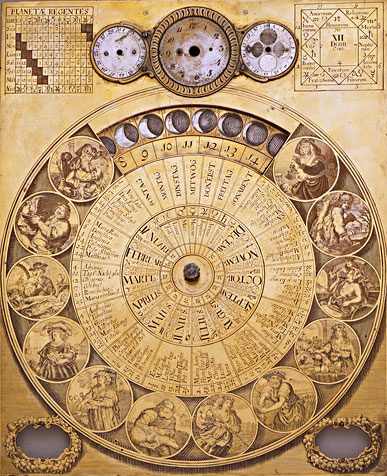
Interesting article on a new book called Rhythms of Life: The Biological Clocks that Control the Daily Lives of Every Living Thing:
Man has invented many ways to measure physical time, from ancient sundials to water and sand clocks, from the pendulum to the wind-up pocket watch, all the way to the modern atomic clock. An example of this latter-day timekeeper, introduced in 1950, measures a second as 9,192,631,770 cycles in the energy radiation of the Caesium atom. This produces an atomic second, which is one-86, 000th of a solar day, and is accurate to one second in three million years. Not bad, if you care about promptness. Whether time is real or not (as philosophers continue to ponder), whether without our constructions it really does “flow,” what unites all clocks is that they measure a well-defined, regular, and uniform physical change of one kind or another.
In their wonderful book, Russell G. Foster and Leon Kreitzman tell us that while our ability to measure time has improved over the ages, we have nevertheless “been steadily losing a battle with time. Instead of controlling our modern clocks, they control us.” Think about it: when we want to know when it is time to eat, or to go to bed, or to plan a vacation, we look at watches and clocks and calendars. Increasingly, these tools become dictators. But consider nature for a moment: without a Rolex or even a Swatch, the monarch butterfly knows to migrate from North America to Central America at precisely the same time each year. With no calendar and no alarm clock, the cicada emerges from the ground after exactly thirteen or seventeen years for a few fleeting weeks of frenzied mating–and the squirrel knows where and when to return to each and every one of its buried stashes of perishable goodies precisely before they lose their value and must be abandoned like surplus cottage cheese in the grocery. Bears hibernate, swallows rise to catch the early worm, and even plants seem as if they are silently counting the hours. . . .
It stands to reason that such rhythms should have been etched into living beings over evolutionary time, for although the week and hour and minute are human inventions, the Earth will rotate on its axis about every twenty-four hours for at least the next five billion years, and the moon will wax and wane every 29.5 days, and the tide will roll over the waves twice a day, and Sirius the Dog Star will rise with the sun every 365 of them. For humans, it is primarily the circadian rhythms that govern much of our behavior (though female readers will rightly protest that I have never experienced certain rattling lunar effects). …
As someone who studies the effects of the movements of the planets on human behavior, I am well aware of the ebb and flow of the cycles of time. I particularly like the ending to this article:
We live in a maniacally fast and busy world, in which television and radio update our every minute and working hours and travel are increasingly heedless of the cadences of our planet. Evolution and chronobiology teach us that our inner and outer worlds are fundamentally connected. But finally how we view time is intimately connected to our dreams and aspirations–the way we would like to see the poem of our lives, and of our world, written. Will we wish to continue our growing detachment from the cycles of the sun and moon and tide and planets, or will nature more powerfully, or rudely, return us to its order? In the end, it may be up to us.
Indeed, many of us are running through our lives like rats in a maze, human do-ings rather than human be-ings. I love the slow days when I’m able to wake with the sun and settle into sleep with the moon – when life is organic enough to pay attention to the lunar phases and the cycles of the planets. To me, the luxury of taking the time to unfold with the planetary cycles instead of reacting to them is the highest form of bliss!
